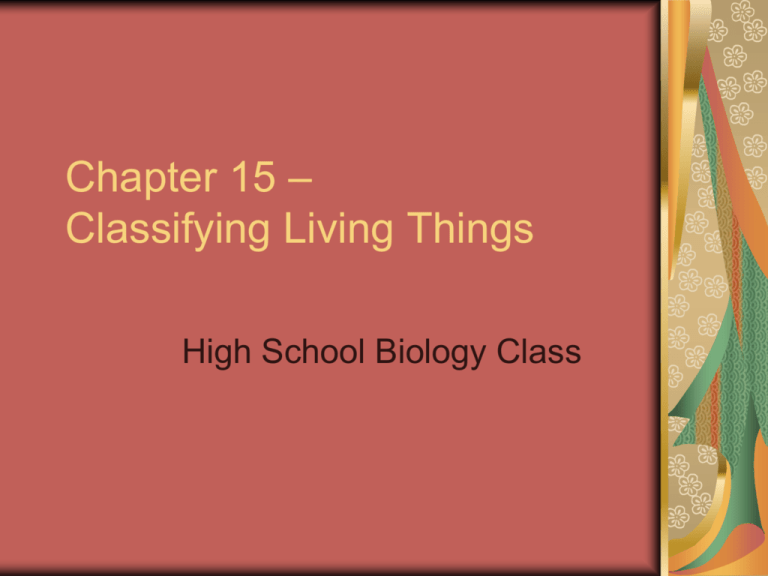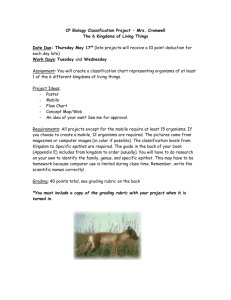File - Dillman Biology
advertisement

Chapter 15 – Classifying Living Things High School Biology Class What is Classification? The branch of science that names and groups living organisms into categories based on their similar characteristics and evolutionary history. Sometimes referred to as taxonomy. Why is Classification Important? Every year, thousands of new species are discovered. Scientists have identified more than 2 million species of organisms, but estimate 40 million species inhabit the Earth. Scientists estimate that there may be millions of species in the tropical rain forest and an unspecified number living in the oceans currently undiscovered. Why is Classification Important? A Universal System is necessary to have clear communication among scientists worldwide. The system was designed to eliminate the use of common names and confusion in the scientific world. When Was Classification Started? Organisms were first classified more than 2,000 years ago by the Greek philosopher Aristotle. He classified things as either Plant or Animal. He grouped animals into three basic categories Land Dwellers, Water Dwellers, and Air Dwellers. He also grouped plants into three categories, based on differences in their stems. When Was Classification Started? As science developed and more was learned about living things Aristotle's system was very INADEQUATE. In the mid-100’s Carols Linnaeus, a Swedish biologist established a simple system for classifying and naming organisms. Linnaeus developed a hierarchy (a ranking system) for classifying organisms that is the basis for modern taxonomy. When Was Classification Started? In his system of classification, he ranked categories from the broadest and most general (kingdoms) to the smallest and most specific (species). Linnaeus also used Latin for the names of the categories and species because this was the language of educated people and not an everyday language that would be likely to change. When Was Classification Started? Additionally, Linnaeus used an organisms form and its structures to categorize it. Linnaeus is called the Father of Modern Taxonomy because his system is still being used today. How Does Classification Work? By learning the Hierarchy and the Naming Process the system becomes more clearly understood. A) The Hierarchy System Linnaeus's classification hierarchy included FIVE levels and modern scientists have added TWO more classifications levels. A. KINGDOM B. PHYLUM/DIVISION C. CLASS D. ORDER E. FAMILY F. GENUS G. SPECIES A) The Hierarchy System How can you remember this? KING PHILIP CAME OVER FOR GOOD SPAGHETTI. This Just In… Scientists have recently added a new level of classification above the kingdoms, called the domain name. Carl Woese, a modern day scientist, proposes the use of the following domain names: Archaea, Bacteria, and Eucarya. B) The Naming Process To ensure accurate communication of information, Linnaeus proposed a system of scientific naming using TWO names for each organism. This naming system is referred to as Binomial Nomenclature. B) The Naming Process The FIRST word (genus) of a scientific name is a description of the group of organisms to which the individual belongs. B) The Naming Process The SECOND word (species) of a name is a general description of the organism, usually an important characteristic it contains, or where it is located. B) The Naming Process When we use the Latin name for an organism, we always capitalize the Genus but not the species identifier. We also print the name in italics or underline them. The scientific name can be abbreviated. For example: 1) Homo sapien = H. sapien 2) Canis familiaris = C. familiaris How Do We Classify Organisms? When placing an organism into a group taxonomists consider its: • Morphology (appearances & behaviors) • Chromosomal Characteristics (traits) • DNA/RNA & Amino Acid Sequences (genes) • Embryological Development (life-cycles) • Fossil Records (past histories) All of the above are used to yield reliable information about the PHYLOGENY or evolutionary history of an organism. How Do We Classify Organisms? Classification is based on the fact that different degrees of similarities exist among organisms. Organisms are similar because the have descended from common ancestors. Thus, the more similar organisms are the more classification categories they belong together in. How Do We Classify Organisms? TWO Approaches: 1) SYSTEMATICS (Family Trees) – show relationships thought to exist among groups of organisms. How Do We Classify Organisms? TWO Approaches: 2) CLADISTICS (Cladograms) – a new system that uses certain features of organisms called, shared derived characteristics, to show relationships. The Kingdoms of Life Linnaeus classified all organisms into TWO kingdoms, Plants and Animals. Modern scientists use SIX kingdoms. Kingdom Monera Archaebacteria and Eubacteria are sometimes combined together into one kingdom called Monera. Together they include the greatest number of living things on the Earth. All members are classified as prokaryotes and reproduce by binary fission. 1) Kingdom Archaebacteria The prefix “archae” means “ancient." Modern Archaebacteria may be directly descended from the first organisms on Earth. They are unicellular prokaryotes with distinctive cell membranes that lack peptidoglycan. Some are autotrophic, but most are heterotrophic. Many Archaebacteria live in harsh environments such as sulfurous hot springs, very salty lakes, and in anaerobic environments, such as the intestines of mammals. 2) Kingdom Eubacteria The prefix “eu” means “true.“ They are unicellular prokaryotes that have cell membranes that contain peptidoglycan. Eubacteria are both autotrophs and heterotrophs. Eubacteria are most often the bacteria (germs) that affect your life such as those involved in tooth decay or food poisoning. 3) Kingdom Protista Referred to as “The Ash and Trash Kingdom” Theses organisms are placed here more because of what they are not than what they are. The Kingdom Protista contains all eukaryotes that are not plants, animals, or fungi. There are more than 50,000 species in the kingdom which include unicellular and a few multicellular eukaryotes like Euglena and Amoebas. 4) Kingdom Fungi Fungi are eukaryotes and most are multicellular. The cells of fungi have cell walls that contain a material called chitin. These organisms are heterotrophic and obtain nutrients by releasing digestive enzymes into a food source. They then absorb their food after it has been digested by the enzymes. Fungi act either as decomposers or as parasites in nature and include molds, mildews, mushrooms, and yeast. 5) Kingdom Plantae Plants are eukaryotic, multicellular and carry out photosynthesis. The cells of plants have cell walls, that contain cellulose. Plant cells are specialized for different functions, such as photosynthesis, the transport f materials, and support. Plants include mosses, ferns, gymnosperms (cone-bearing plants) and angiosperms (flowering plants). 6) Kingdom Animalia Animals are multicellular, eukaryotic and heterothophic. Animal cells have no cell walls. Most members of the Animal Kingdom can move from place to place. Although some are permanently attached to surfaces such as sponges and barnacles. Animals include fish, birds, reptiles, amphibians, and mammals (including humans). Kingdom Relationships The kingdom development is thought to look something like shown below: Any Questions? “If you don’t like the way the world is, you change it. You have an obligation to change it. You just do it one step at a time.” --Marian Wright Edelman “The best way to have a good idea is to have lots of ideas.” --Linus Pauling








